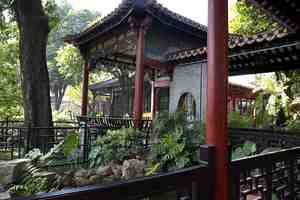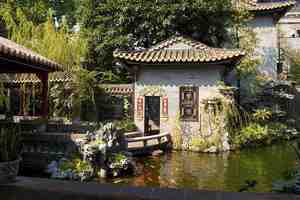 It's a space for reflection, where raindrops fall on the broad, shiny leaves of banana trees, where the scent of osmanthus blossoms finds you -- sitting in a shaded nook you happened upon unexpectedly.
It's a space for reflection, where raindrops fall on the broad, shiny leaves of banana trees, where the scent of osmanthus blossoms finds you -- sitting in a shaded nook you happened upon unexpectedly.
It's the classical Chinese garden.
"Chinese scholars' gardens have traditionally been created as a small paradise within the busy activities of the city," said Ina Asim, UO professor of history. Asim is involved in the renewal of research on Chinese gardens and the creation of such gardens within the U.S. and abroad.
Asim is creating a website that will utilize video, text and photography to trace the development of the gardens within China, as well as their later export to countries around the world. The collected materials will be designed for use in classrooms, for research and for personal exploration.
 The popularity of urban garden refuges began during China's Song Dynasty (960-1279) and peaked during the Ming Dynasty (1368-1644). Strongly influenced by Daoist and Confucian ideas about the importance of meditation and reflection, the gardens were thoughtfully designed spaces where an elite and well-educated group of scholar-officials could find balance between their civil service responsibilities and their home lives.
The popularity of urban garden refuges began during China's Song Dynasty (960-1279) and peaked during the Ming Dynasty (1368-1644). Strongly influenced by Daoist and Confucian ideas about the importance of meditation and reflection, the gardens were thoughtfully designed spaces where an elite and well-educated group of scholar-officials could find balance between their civil service responsibilities and their home lives.
Part of this design required that the gardens' architecture complement the natural environment. If a stream ran through the original space, it not only must be retained but its symbolism also should be incorporated into the overall design. "You add. You don't take away," said Asim. Asim became intrigued by the Chinese garden while working with the Social Science Instructional Laboratory (SSIL) to digitally restore a 17th century silk handscroll, "Colorful Lanterns at Shangyuan." The painting features crowds of people at an antiquities market during the Lantern Festival in Nanjing, the secondary capital of the Ming Dynasty.
 Asim worked closely with Garron Hale, assistant director of SSIL, to digitally wash away the centuries of grime that had settled over the silk painting and obscured the scroll's original brilliance. She is currently working with the Wired Humanities Projects on the restoration of another scroll featuring a scholar-officials' poetic gathering.
Asim worked closely with Garron Hale, assistant director of SSIL, to digitally wash away the centuries of grime that had settled over the silk painting and obscured the scroll's original brilliance. She is currently working with the Wired Humanities Projects on the restoration of another scroll featuring a scholar-officials' poetic gathering.
These scrolls and other documents from the Ming Dynasty reveal the importance of the gardens to the scholar-official's life and how paintings such as "The Gathering at the Orchid Pavilion" greatly influenced the way Chinese gardens were designed. The gardens were often reflections of landscape features and architectural elements depicted in paintings.
Beginning in the 1980s, the Chinese garden was exported to countries around the world, with several cities in the U.S. creating gardens for public use. Portland created its Lan Su Chinese Garden in 2000, blending its natural environment with indigenous Chinese plants and other elements, such as rocks and water, that are essential to the traditional design.
"These aren't just botanical gardens," said Asim. "They are the confluence of Chinese concepts of nature and culture in a small space, combining a maximum of visual and other sensations."
- Anne Conaway
photos by Kay Bork


 When the volcano erupted, a UO professor discovered that local residents consoled themselves through song.
When the volcano erupted, a UO professor discovered that local residents consoled themselves through song.
 Join UO neuroscientists as they bring the host of the PBS series, The Human Spark into their brain research lab.
Join UO neuroscientists as they bring the host of the PBS series, The Human Spark into their brain research lab.  Temple Grandin, perhaps the world's best known person with autism, drew an overflow crowd to her UO talk.
Temple Grandin, perhaps the world's best known person with autism, drew an overflow crowd to her UO talk.

 Watch a slideshow about Elena Rodina's journalistic globetrotting, from the Arctic Circle to Cuba.
Watch a slideshow about Elena Rodina's journalistic globetrotting, from the Arctic Circle to Cuba.